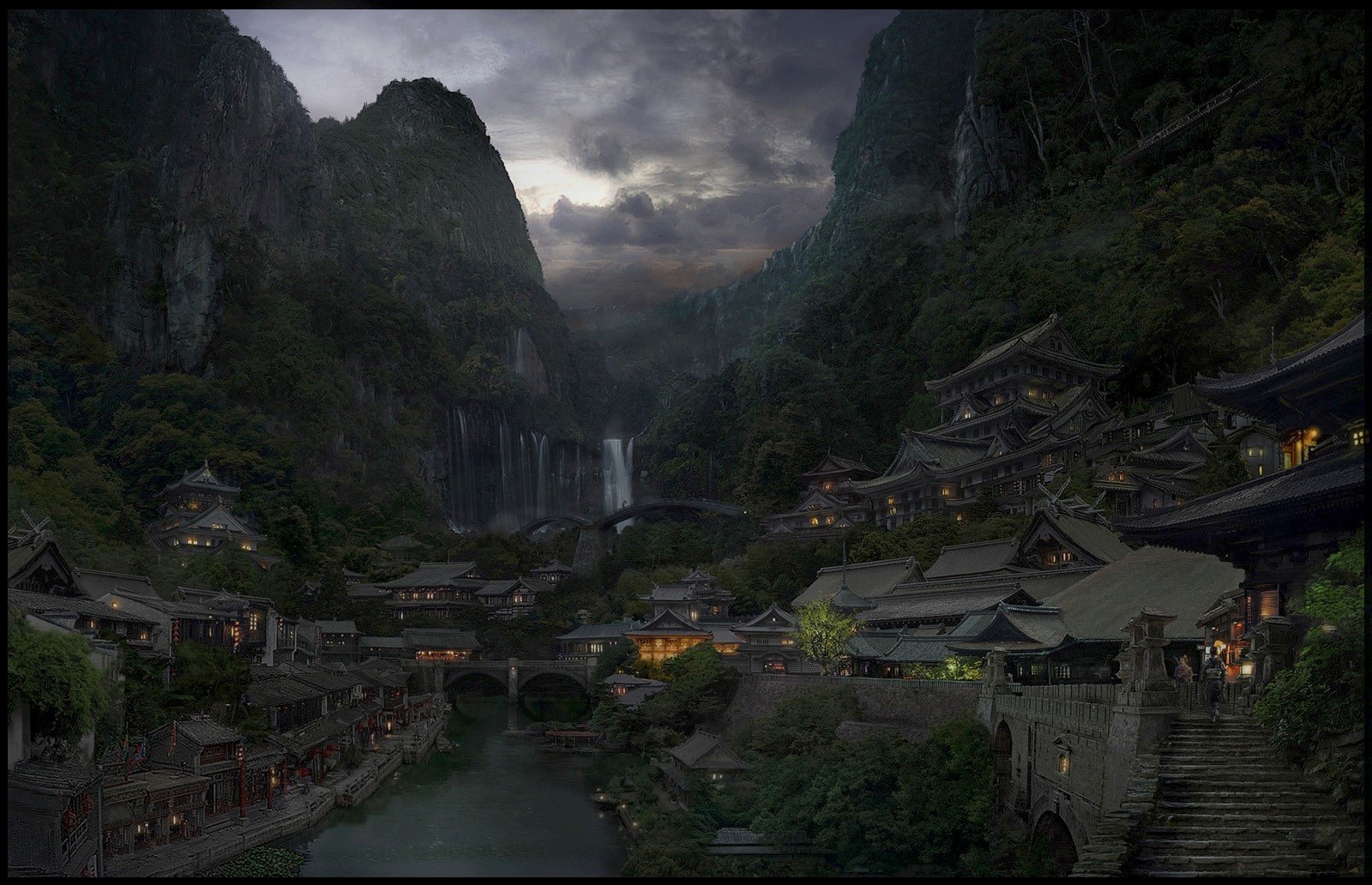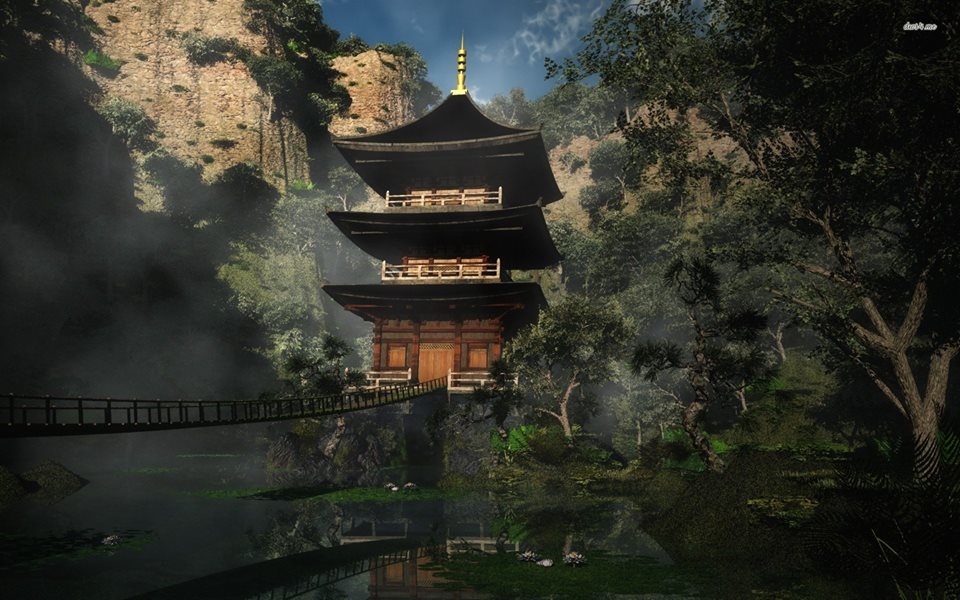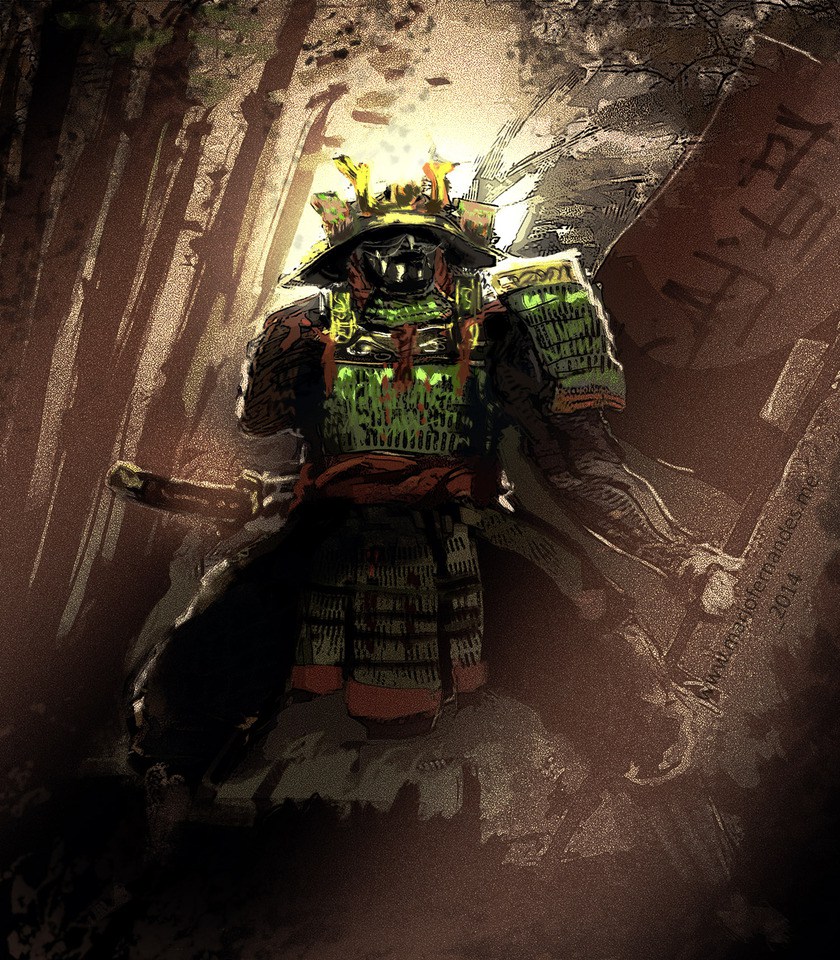Yoe Tao
A steaming city full of life and vigor, Yoe Tao is the home of the renowned Kenshu warriors, the only city in Ilucin to forge and export Malachite, and the birthplace of the Nigen philosophy. Although the city itself is isolated deep in the Nenshiito River Valley, nestled between the Emerald Peaks, it is very welcoming to visitors and merchants in times of peace. Many rogue forces have their eye set on the city and it’s unique and valuable goods. When war times arise, the taotian people defend their home with furious tenacity and unbreaking spirit.
Demographics
Yoe Tao consists of roughly 40 percent human, 15 percent dragonborn, 20 percent elf, 5 percent half-orc, 10 percent dwarf, and 10 percent other races. The Soemer humans and elves of the region all have a characteristic look with thick, straight, black hair and narrow eyes, and flat nose bridges.
The primary language of Yoe Tao is Common, but Draconic and Elvish are spoken frequently enough that several establishments in the city have texts and signs in the two languages.
Government
The Yoe Tao Niome is headed by two rulers: the Gazu and the Seijura. Each with their own selection process and designated responsibilities, yet they consult each other for major decisions. The twin governance is seen and understood as a way to prevent corruption of power. The people of Yoe Tao tend to believe in this system fully and perceive single ruler governments as foolish.
The Seijura is a public figure that is selected by open vote. The Seijura interacts with the people of Yoe Tao on a daily basis, holding public meetings and offering counsel to citizens in trouble. Often involved with the dealings of more mundane policies such as taxes, trade, and lawmaking. The Seijura is tasked with being the voice of the people and overseeing domestic affairs of a non-military affect. Because the Sejura is selected by popular vote, those chosen are often war heroes or have become well known for deeds within Yoe Tao.
The Gazu is the cultural and philosophical leader tasked with responsibility of being the judgemental leader for determining punishment. While not interacting with the people as directly as the Seijura, the Gazu is a title that warrants both respect and fear. Because the position is a symbol of willpower and resolve, the Gazu holds position until death or is otherwise removed. When the time comes to select a new Gazu they are selected by a committee known as the Hidora.
Philosophy
The Hidora is the main philosophical council in Yoe Tao and they study an amorphous, formless entity known as The Nigen. The Hidora is a reclusive group that resides in Soe Jai temple, deeper in the valley than the main body in the city. Entry into the Hidora requires extensive and cruel judgement of one’s devotion to study of the Nigen. The numbers of the Hidora have waxed and waned throughout the years, the lowest ever being three members and the highest near one hundred. The Gazu is the leader and figurehead of the Hidora and is often chosen from the current members, though not always. This process, called the Hak, only begins after the previous Gazu has died or otherwise been removed from their seat, during which the city enters a somber state of affairs and normal city business comes to a halt. During the Hak, The citizens of Yoe Tao make a daily pilgrimage deeper into the valley and congregate near the bridge to Soe Jai Temple and spend most of their time meditating. Meanwhile, the members of the Hidora deliberate on who should ascend to the position of the Gazu, this decision must be unanimous. This sometimes takes mere moments, sometimes it lasts weeks.Defences
The Kenshu may be the most recognizable military force in the city, but they have very limited numbers. The Niome controls a small army of soldiers that are trained and lead by the Kenshu. These soldiers are not as thoroughly trained or as well equipped as their leading officers, and do not receive malachite weaponry. Though they are commanded by the Kenshu, their direct allegiance actually lies with the Gazu and the Seijura. This contradiction occasionally results in petty conflict and squabbles within ranks and between the Niome and the Kenshu, but not in any large-scale conflict.
The city’s walls are also bolstered with a plethora of unique defenses that have been augmented or designed around using malachite. The walls are stationed with the characteristic taotian ballista, with six arms made of greenwood and ropes of emerald silk, they are incredibly powerful. Instead of using traditional hot cauldrons to defend their gates, flash freeze is used to immobilize anything at their gates. This is where the fire belchers arrive, perhaps the most notorious of taotian defences. Designed as large horns shapes with the bell near the ground outside of the wall and the mouthpiece on top. From the top, they can be loaded with powderized green fire, and ignited. When ignited, the green fire begins burning furiously and is thrown from the mouth of the horn with the excessive heat. These are only effective at very short range but are devastating.
Industry & Trade
The diversity of resources and supplies available to artists of Yoe Tao make sculptures, paintings, and tapestries, some of the most common exports of the city. While many of these may be a commodity to the taotian people, they are quite rare and valuable to the rest of Illucin. The most famous exports from the city are these art pieces made from malachite. The most desired being pure malachite busts and statues smithed by Kenshu Elders themselves, simply due to their rarity.
Within the city, most trading is comprised of smithing or food. Because the common blacksmith does not have access to malachite or any means to smith it, they have collectively come together to form a guild and work very cooperatively with one another. The Taotian Smithing Guild very actively supports miners in the city who provide them with materials for their craft. Mining is one of the most common jobs in the city and is very difficult. The mines are even hotter than the city itself and the constant humidity makes everything wet. This leads to an unfortunate amount of infection and injuries among the miners.
The food industry in Yoe Tao is also quite popular, in both domestic trade and exports. Many of the regions foods rarely grow in other parts of the world due to the climate, and underwater agriculture is almost exclusive to the city itself. This attracts much interest from rich lords and ladies who wish to taste exotic cuisines.
Due to the lack of cultivation of many jungle plants, a job of “jungle running” has become quite popular in the city as both a profession and a hobby. A jungle runner’s job is to traverse the forestry and gather foods such as fruits, herbs, and spices among other things. There are two common jungle running techniques: ground-crawling involves walking along the forest floor with a basket and a large pole for knocking things down from the branches, and branch-hopping includes running along the branches and the treetops to gather foods by hand. Jungle running is very popularized in the city, particularly branch-hopping, and many competitions are held to test who the best jungle runners are.
History
For roughly half a century after the Crimson Eclipse, the beginnings of the Kenshu order lived in solitude in the Nenshiito River Valley. They learned how to tame the wild that grew around them and how to survive in peace. When stories of their survival spread, so did interest in the Isles of Soemerild. Many prospective warriors began traveling to the Bastion to seek training from Maro and the heroic warriors who fended off the beasts of the Incursion without magic. This idea became so popular, in fact, that the Kenshu resorted to turning away newcomers. Not only because there were not enough Kenshu to train them or enough resources to keep them fed. This led to an accumulation of citizens outside the Bastion which became the foundation for the population of Yoe Tao.
Over the next fifty years, some of these citizens would return from where they traveled from, but many stayed and made homes in the valley. They learned to take advantage of the forest and learned to survive quite comfortably. The local wildlife was dangerous, though. For this reason, they stayed very near to the Bastion and struck an arrangement of sorts with the Kenshu. A trade of protection for food and resources. The Kenshu would defend the nearby peoples in return for a steady supply of food for the warriors.
This deal, made in 122 ACE, marks the beginning of Yoe Tao as it is known today. Over the next century, the Kenshu and citizens would together build the walls that stand today, Soe Jai temple, and the Seijura’s palace. The walls, which marked an important division between the harsh wildlife of the jungle and the taotian people, allowed for the population to expand dramatically and the government to begin forming.
The position of Seijura is named after the first person to be recognized as a public figurehead among the citizens. Kiryu Seijura was a charismatic and respected citizen who united the people when they were on the edge of a violent conflict over scarce supplies after a destructive typhoon. While there is no exact year recorded in which he assumed such a role, it is thought to be close to 175 ACE.
The first Gazu was a man named Reiyo Ito. A philosopher who lived not long after Kiryu Seijura, who was fascinated with the Kenshu’s discipline and strategy in battle. Particularly, their mantra that states every decision made sacrifices one thing to obtain another. While Maro’s original intent was to describe how aggression can leave openings in one’s defense, Reiyo believed this could extend to other aspects of life. He eventually generalized this to a concept of duality that permeates everything in the world and described this as an entity known as the “Nigen”. The people of Yoe Tao were very welcoming to these ideas and they were eventually embraced as part of the city’s culture, making Kiryu a philosophical leader of the city.
Geography
Yoe Tao lies deep in the Nenshiito River Valley. The Nenshiito River itself is nestled between the western side of the Emerald Peaks and runs with steaming hot water. This water comes from deep underground and surfaces in a basin at the end of the valley, where Soe Jai temple is built. The rest of the valley, outside of the city walls, is overrun with dense rainforest and jungles. The Emerald Peaks are surprisingly tall for an island the size of Gadene.
Natural Resources
The city lies on the northern side of Gadene in the Nenshiito River Valley. This river carries steaming hot water towards the sea and runs through a dense tropical jungle. As a result, agriculture in Yoe Tao has taken on a unique form. The jungle prevents most traditional farming techniques due to the lack of land, the only fields where food can be grown is in paddies along the mountains. The hot river waters have led to the cultivation of many aquatic plants for food, underwater gardens are very common in the city and some citizens even make a career out of aquatic farming. The forest is also home to many varieties of fruits, herbs, and other forms of useful plant life that the citizens take advantage of to make foods, pigments, and many other things.
The Emerald Peaks that surround the city are also rich with metals and ores. Iron, precious metals, and even gemstones are often found in these mines. Most notably, though, is the presence of malachite ore. Being so hard and heavy, the metal is very difficult to mine, but is extremely valuable when properly smithed.
The Kenshu
The Kenshu are an important presence in the city of Yoe Tao. They are deeply rooted in the history and culture and appear in many forms of art throughout the city.
Alternative Name(s)
The Emerald of the Isles
Type
Large city
Population
20000
Inhabitant Demonym
Taotian
Owning Organization
Related Tradition (Primary)
Characters in Location



Comments